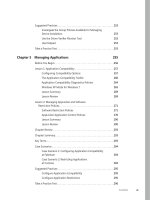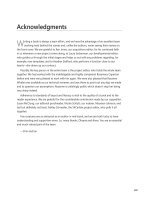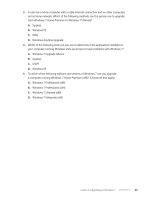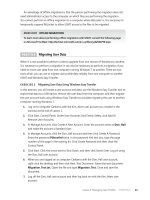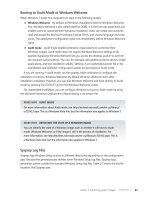21 hypertrophy training progression part 2
Bạn đang xem bản rút gọn của tài liệu. Xem và tải ngay bản đầy đủ của tài liệu tại đây (371.63 KB, 19 trang )
UNIVERSITY
Hypertrophy
Training
Progression Part 2
The Lesson
PART I
Programming a Training Block
Understanding Progressive Overload
Volume Load Progression as a Gauge of Progress
PART II
How to Progress Reps and Load
How to Progress Effort
How to Progress Set Volume
Autoregulating Set Additions
PART III
Lift Progression Trouble Shooting
Progression During Contest Prep
Progression During a PED Blast or Cruise
Progressing Load and Reps Over the Training
Block
Single Progression: increasing only reps or load for a set/sets
Double Progression: increasing reps first and then increasing load within
a rep range.
Problem with both strategies: this does not account for the rate of a
person's adaptation. For a beginner this might under dose stimulus, for an
advanced athlete it might overdose the stimulus. Also, true progress can
be hard to gauge.
Dynamic Double Progression: increase reps and/or load within a given
rep range to meet a standard high relative effort target level.
This accounts for rate of adaptation and keeping pace with that
adaptation for progressing stimulus. More focus is given on effort of the
set than load or reps used to accomplish that.
Allows for autoregulation based on the day when readiness is high or low
Dynamic Double Progression
Example: 1 set 6-10 and 1 set 10-15 reps RIR 1-0 Hack Squat
Wk 1
500lbs x 8 RIR 1
430lbs x 12 RIR 0-1
Total VL: 9160
Wk 2
505lbs x 9 RIR 1
430lbs x 14 RIR 0-1
Total VL: 10565, +13%
Wk 3
535lbsx 8 RIR 1
430lbs x 16 RIR 0-1
Total VL: 11,160; +5%
WK 4
535lbs x 9 RIR 1
470lbs x 12 RIR 0-1
Total VL: 10,450; -6%
Dynamic Double Progression
WEEK 1
pick a load you can hit within the target rep range and get to that high
effort ALL OUT set.
Based on the first set adjust the load to stay within the target rep range.
Typically a 5% weight change will + or – 2 reps and 10% weight change
will + or – 4 reps. and 20% weight change will be +/- 7-8 reps.
WEEK 2-8
The next session work to increase reps to the top of the rep range for
your sets.
If you get to the top of the rep range increase load to start back at the
bottom of the range and work back up.
Some days you can increase load and reps when progression is fast. In
this case go for it! 5-10% load increase along with rep progression.
Remember the effort level is THE most important thing, use the load
needed to hit that high effort level within the hypertrophy rep range 6-20
reps.
Advanced lifters you might only be making 2.5-5% load additions every
week or every other week.
Progressing Effort Level Over Training Block
Sets need to be “hard” for effectiveness and should be close to failure
Week 1
Start your training block with RIR 1-2 to adjust to new lifts and
exercise order. This can be lift specific as well. (ie adding in squats
after not doing them for months). Beginners RIR might need to be
adjusted lower for safety.
If lift proficiency is high RIR 1-0 is appropriate, more application for
advanced lifters
Week 2-8*
Maintain high effort RIR 1-0 and utilize dynamic double progression
Effort level will be kept constant during training block
*8 week noted as end of block
Progressing Set Number Over Training Block
Week 1
Start your training block based of current training volume or metaanalytic data (Beginner 5-9 sets per week; intermediate/advanced 820 sets per week)
Week 2
Hold set volume constant
Lift proficiency increases
Adjustments to week 1 set up if needed
Focus on Load rep progressions
Week 3-8
Autoregulate set volume additions*
*more applicable for advanced lifters. For beginners and
intermediates hold set volume constant and adjust every 8-week
block.
Autoregulating Set Volume Additions
All lifts are progressing, and recovery is great, should I add
volume?
1. If lifts are progressing, pumps are great, and recovery is
high. Adding a set might be a reasonable move to make
to ensure you don’t underdose volume.
1. I would advise to increase set volume 10% first and then
evaluate gym performance for the next week to make
sure you can recover. Remember if you are making
progress take it, too many sets can quickly drop you into
high fatigue.
1. Adding sets more conservatively from mesocycle to
mesocycle can give a more conservative time course to
evaluate progress and recovery.
1. Advanced lifters adding sets on specific body parts or
isolations movements. Application for rest pause and
drop sets)
Training Block Progression
Summary
WEEK 1
Beginner
Intermediate/
Advanced
8-20 sets per
Volume set # 5-9 sets per muscle muscle
Effort
RIR 1-3
Load/Reps
Dynamic Double
Progression
RIR 0-2
WEEK 2
WEEK 3-8
Beginner
Intermediate/
Intermediate/
Advanced
Beginner Advanced
HOLD
constant
Hold
Hold constant constant Autoregulated
RIR 1-2
5-10% load
progression
Dynamic Double and/or rep
Progression
progressions
RIR 0-1
2-10% load
progression
and/or rep
progressions
RIR 0-2
RIR 0-1
same
same
This is only one way of Training block planning, you can
manipulate more variables, however this will give you more
unknowns in evaluation.
Evaluating the Training Block
Muscle growth can be slow, especially at the advanced level
We can track visuals, body fat, and circumference for long term trends
Short term we should look to the logbook for progress
Check your logbook that volume load has progressed, lifts are moving
upward across the board
Check for progression on lifts and lifts that are stalling swap them next
block
Change lifts that are causing any soft tissue or joint issues
If lifts are still progressing keep those in place, no reason to change them.
Big picture if lifts are progressing up in load and reps you are
programming correctly. Your rate of progress is your own rate of progress
comparable only to you.
End Part II
Lift Progression Trouble shooting
The more advanced you are less progress session to session you
will make. Progress on just one lift is a win for the day.
What if most lifts are progressing except a few?
1. Might just need more time to work the lift, I would give it 3
sessions before rotating it out.
1. Also try varying loading week to week to try to drive up the
lift. So if hitting 400lbs x 10 reps every week, Jump to 440 x
6 reps one week, then the next week back to 405lbs and try
to match or beat the reps.
1. Double check to make sure its just not an off session and
sleep, hydration, nutrition, stress all need to be on point. So
don’t write off one lift if maybe you just lost some stamina
in the session.
Lift Progression Trouble shooting
I progressed my first lifts, but my other lifts dropped off in
performance?
1. Large jumps in performance on first lifts might lower
performance on subsequent lifts from greater fatigue. This
can be acceptable, but make sure you trend upward on all
lifts over the training weeks.
1. You might not progress on your first set, but progress on the
second set. This is common using top and back off sets and
acceptable progression.
1. Double check to make sure its just not an off session and
sleep, hydration, nutrition, stress all need to be on point. So
don’t write off one lift if maybe you just lost some stamina
in the session.
1. Did you decrease your rest times between sets?
Lift Progression Trouble shooting
I progressed my first lifts, but my other lifts dropped off in
performance?
5.
Evaluate that first lift and make sure the progression wasn’t
based on changing mechanics, ROM, or bar speed.
5.
Progressing a lift is sign adaptation has occurred, but some fatigue
might be accumulating quickly, if you see a persistent drop off in
performance might be time for a deload or a few lower volume
training sessions.
5.
If all sessions are getting lengthy and fatigue is getting high at the
end of sessions might be time to progress up to the next training
split to manage stimulus and fatigue.
Lift Progression Trouble Shooting
All lifts have stopped progressing?
1. Are you nailing sleep 7-8 hours , nutrition (calorie
surplus), stress management? If no, then nail all these
variable and see if progress ensues.
1. I am nailing all the above variables! Are you motivated to
train or dreading the gym? Is your PRS score <4? Load
and reps are decreasing? Aches and pains higher? Sleep
poor or Hunger less?
1.
2.
If YES to 2 or more of the above, you are likely not recovering and
need a deload and if this occurs again in less than 3 weeks you
need to train with a lower volume amount.
If NO to all questions or yes to only 1 item you are recovering but
it might be time to increase training volume via adding sets or
moving up a training frequency tier.
**Managing Fatigue and Deloads will be in our next lectures!
Lift Progression Trouble Shooting
Adding sets when not progressing and recovery is great?
1. Make sure technique is not the limiting factor. Most weak body
parts are held back by poor set quality and doing more sets is not the
answer.
2. If technique is solid add sets across a few lifts that cover all body
parts. If you are advanced, you might start with a couple body parts
first. More advanced might favor isolation movement set additions
over multi joint to manage fatigue or running PPL specialization cycles
to focus volume on one body part.
3. If stalled on just one body part start with a set addition just for that
body part.
4. Go slow as a set addition is a large stimulus, a 10-20% increase in
set volume is a starting point. So if doing 10 sets of chest move up to
11 sets for a few weeks.
Progressing During Cutting/Prep
During contest prep overload training will be limited and slower due
to lower recovery capacity.
Continue to train the SAME as you did in the offseason. What made
you grow is what will keep muscle on.
Do NOT lessen your effort in the sets, this is what is making you sets
stimulating.
This is NOT the time to add in more sets, unless your recovery is
phenomenal.
Your goal regardless is to attempt to progress the stimulus.
Part of prep may end up being a drop in performance for some this
won’t happen (via PEDs). But in Fatigue Management we will learn
how to manage fatigue to keep training hard.
Progression with PED Usage
Progress can be enhanced at a faster rate, still follow the same
progression model and add sets if recovery is very high.
Caution! Rate of strength increase can exceed rate of connective
tissue strengthening so be reasonable on rapid load only progressions.
All other topics from this lecture apply the same to natural or a PED
user.
Coming off cycle, may decrease recovery capacity you will simply train
a within a volume level you can recover from and still attempt to
progress your lifts.
For advanced PED users cruise periods might be closer to maintenance
at best and lower volume and frequency's can be used but keep sets
HARD!!
Summary
• Progressive Overload is a way to keep pace with an adaptation, so
training remains stimulating for growth.
• Our main progression tool is increasing load and reps to ensure our
sets remaining stimulating for growth.
• Dynamic Double Progression is the system to use to move up in load
and reps week to week.
• Stalls in lifts can be evaluated using recovery markers and
determining if more or less training is needed.
• During dieting phases training will remaining the same but we will
use fatigue management strategies to keep training effective.
• PED users and naturals can train the same; the 2 things that change
will be rate of progress and required volume levels.
References
Beardsley, C. Hypertrophy: Muscle fiber growth caused by mechanical
tension. Strength and Conditioning Research Limited, 1 edition; 2019.
Baz-Valle, E.N., Fontes-Villalba, M., Santos-Concejero, J., Total Number
of Sets as a Training Volume Quantification Method for Muscle
Hypertrophy: A Systematic Review. J Strength Cond Res, 2018.
Schoenfeld B. Science and Development of Muscle Hypertrophy.
Champaign, IL: Human Kinetics; 2021.
Minor, B., Helms, E., Schepis, J. Re: Mesocycle Progression in
Hypertrophy Volume Versus Intensity. J Strength Cond Res, 2020. doi:
10.1519/SSC.0000000000000581


